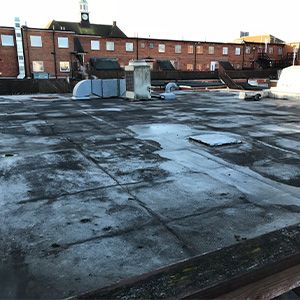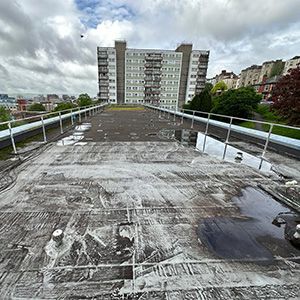Thinking of using cold liquid applied waterproofing for your next refurbishment project? These are the key considerations you need to factor into your decision.
What type of roof are you working with?
Different flat roof build-ups, materials, and conditions may require specific product formulations and application techniques. The choice of cold liquid applied waterproofing system needs to be tailored to the roof’s substrate or even sometimes the building use. Failing to consider the flat roof substrate can result in ineffective waterproofing, reduced durability, and increased maintenance costs. Triflex can work with you to ensure your waterproofing system meets your project aims through their consultative and supportive approach.
What is the condition of the roof?
Roof condition is an essential factor to consider as it will directly impact the success of the waterproofing application. If the roof has structural damage, leaks, or deterioration, these issues should be defined and considered as part of the project before installation of the waterproofing system. Additionally, assessing the roof’s condition helps determine whether any surface preparation or priming is necessary to ensure proper adhesion of the liquid applied waterproofing membrane, contributing to the overall effectiveness and longevity of the waterproofing system.
Thankfully experts are on hand to provide a free flat roof condition survey as part of the Triflex approach to supporting specifiers and asset managers.
The suitability of substrate
The suitability of the existing substrate directly affects the adhesion and bonding of the waterproofing material to the roof surface, ensuring a secure, long-lasting waterproofing solution. Compatibility between the chosen waterproofing system and the specific substrate is essential to prevent issues like delamination. Additionally, the condition of the substrate plays a key role, as surface defects, cracks, or contaminants may require preparatory work. Evaluation of the substrate’s structural integrity is vital, particularly in warm roof build-ups where water ingress may have occurred. Characterising the roof can be achieved through core sampling, helping to identify the condition of the existing roof build-up as well as possible remedial works. With Triflex cold liquid applied waterproofing solutions, roof refurbishment can often be achieved through overlaying the existing system, without the need for costly strip up, thereby reducing wastage.
Upgrades And Improvements
You should also take into consideration any thermal upgrades and improvements to things such as walkways on your project's roof. Thermal upgrades will enhance energy efficiency, and control condensation. Additionally, these enhancements improve safety and accessibility, facilitating maintenance activities and ensuring safe access to roof-top equipment. By addressing these aspects, the overall performance and durability of the building and its waterproofing system are significantly enhanced, ultimately leading to a more sustainable and cost-effective solution.
The Key Benefits To Cold Liquid Applied Waterproofing
Homogeneous waterproofing
Due to the seamless and homogeneous nature of cold liquid applied waterproofing, the flat roof’s main area and details are waterproofed as one. This reduces the risk of water ingress through laps, seams and fixings.
Minimal waste
Typically involves precise application without excessive material use, contributing to sustainability and reducing disposal costs. Often able to overlay existing waterproofing membranes, no strip up is required. You’ll get minimal waste and maximum value.
Rapid curing
With super fast curing times, you benefit from faster project completion, reducing downtime, and enabling quicker building occupancy or project turnover.
Minimal disruption
With no specialised equipment or hot works and associated risks, cold liquid applied waterproofing offers minimal disruption to occupants, making it ideal for projects where maintaining normal building operations is crucial, such as in hospitals or commercial spaces.


